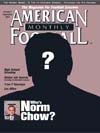AMERICAN FOOTBALL MONTHLY THE #1 RESOURCE FOR FOOTBALL COACHES
Article CategoriesAFM Magazine
|
A Whole New Ball GameCoaching in alternative leaguesby: Richard Scott © More from this issue Warren Moon carved out a pro football career in the Canadian Football League before the National Football League finally came calling and gave him the chance to be one of pro football’s all-time most productive passer. Kurt Warner found success in the Arena Football League and NFL Europe before becoming one of the NFL’s best passers and a Super Bowl winner with the St. Louis Rams. Brad Johnson laid the foundation for an NFL career with Minnesota, Washington and Tampa Bay by gaining valuable playing experience in NFL Europe. Now he, too, owns a Super Bowl ring. In fact, as the NFL season begins, 29 former NFL Europe quarterbacks were competing for roster spots. And then there’s Tommy Maddox, who resurrected a dead career in the Xtreme Football Lea....The full article can only be seen by subscribers. Subscribe today!
|
|
|||||||
| HOME |
MAGAZINE |
SUBSCRIBE | ONLINE COLUMNISTS | COACHING VIDEOS |
Copyright 2025, AmericanFootballMonthly.com
All Rights Reserved





